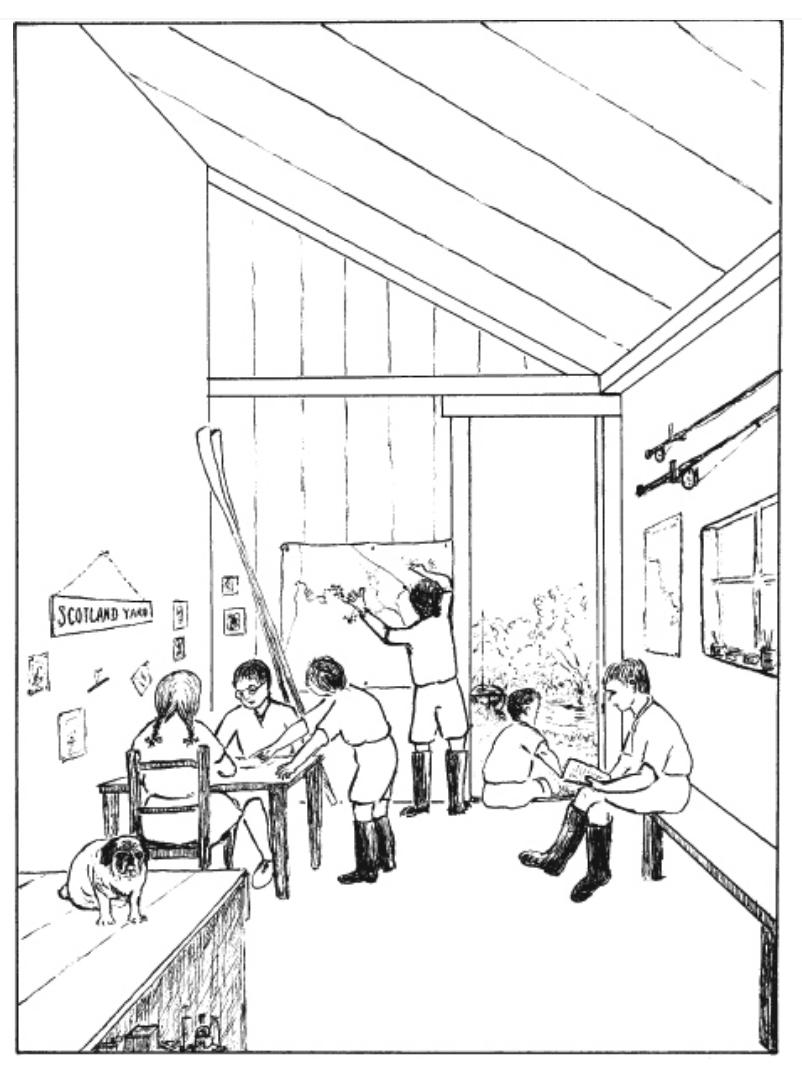Swallows and Amazons and objects
I've just finished a read through of the Swallows and Amazons books. Sort of, anyway; I skipped three out of twelve for reasons I'll get to. This is partly a mini-review of the series, and partly a weird exploration of some stuff to do with how my perception of the world has changed in the last couple of years.
I wasn't expecting to enjoy these books anywhere near as much as I did. I read them all as a kid – the local library had them, and I can remember the distinctive row of fat blue-and-yellow spines on the shelf – but they were never favourites. I found the pace a bit slow, and anyway I generally preferred fantasy books with magic and talking animals. But then a couple of months ago I finally ran out of pony books and decided to give boats a try instead. Somehow they were exactly what I wanted to read and I quickly got obsessed.
I can see why I struggled with the pace as a kid. The story unfolds at an extremely leisurely rate, with every small detail of everyday life left in. For instance, practically every book has several pages devoted to descriptions of going to the local farm with a milk can to get milk for the day. Ransome wouldn't want you to worry that they'd forgotten, so he repeats this for every day of the adventure. Then of course they have to eat as well, so he describes all of the meals. It's pretty much always some combination of corned beef, eggs, potatoes, bread and butter, peas, apples and chocolate, washed down with mugs of tea, but he still needs to include today's variant. Maybe it will be cocoa today instead? Or they'll hot up a tin of steak and kidney pudding? Then there's tents to put up, and fires to make, and washing up to do, all before they even get on the water. And when they finally do sail, there are pages more description of luffing and tacking and reefing and booms and jibs and halyards, and then probably they need to wash down the deck or something, and...
Maybe this sounds like I'm complaining, but actually as an adult I absolutely love it. There's something wonderfully vivid about the way he describes things, so I'm genuinely excited to find out what's for dinner this time even if I've already read twenty descriptions of other similar dinners. Right now I seem to be hungry for this kind of dense description and can eat an arbitrary amount of it.
Here's a couple of examples of what I mean. I could find others in almost any chapter of any book, but these are two I highlighted. First, here's Tom looking for pins in The Big Six:
‘Good,’ said Tom, and rattled one small tin box after another to find the one with the thin noise of pins among all the boxes that made the noise of screws or nails.
Most people would just say something like "Tom got the pins", if they said anything at all, but Ransome puts in that little extra bit about the thin noise and suddenly I can almost hear it myself, and imagine the tactile feelings of shaking the different boxes.
Second, here's a part of the description of the farmhouse kitchen belonging to the elderly Swainsons in Swallowdale (they've gone there to get the milk, of course). He could just fill in a few generic sentences of <insert rustic description here>, but instead we get:
There were white lace curtains to the low windows, and in the deep window-seats there were fuchsias in pots, and big spotted shells. Each shell had its own thick knitted mat, and the pots were in saucers, and each saucer had its knitted mat, just as if it were a spotted shell.
Spotted shells on thick knitted mats! Perfect.
My favourites of all are the two Norfolk Broads books, Coot Club and The Big Six. These are set in the real landscape of the Broads rather than his patched-together version of the Lake District, and everything feels extra solid and present – the eelman, the wherries, the Yarmouth wreckers. (They also have slightly more of a plot, with a bit of real conflict, though it's still the same leisurely pace.)
At the other end of the scale, I didn't bother with Peter Duck, Missee Lee or Great Northern? at all. The first two are strange books that Wikipedia describes as 'metafictional': they're supposed to be stories that the children make up. I really don't care about Ransome's invented versions of China and the Caribbean when it's the texture of his writing about real places that I love so much. I don't remember much about the plot of Great Northern?, but according to Wikipedia it's somewhere between the two metafictional books and the normal ones, with a story set in Scotland that's more plausible but still doesn't fit the standard school-holiday-adventure mould. It might be OK, but the vague memory I have is of not enjoying it much, and I don't want to spoil things now.
Why am I so obsessed with reading about milk cans and jars of pins at the moment? I don't really know, but it has something to do with how I've turned up the volume on the world of objects in the last couple of years. I think Marie Kondo-ing all my stuff during boring lockdowns started off the process, by getting me to engage far more closely with my surroundings than I was used to. That really rewired me perceptually, and I now enjoy lots of small tasks like folding clothes and flattening cardboard boxes that didn't mean much to me before. Meditation is also probably having some influence on this.
Anyway, there's definitely something going on with objects, because when I try the image streaming method of improving visualisation ability I just get a constant stream of them, with lots of very fine-grained, close-up visual and textural detail. Lots of memories of objects come back. And apparently I want to read all about them too.
There's another funny resonance here for me. Ransome illustrated his own books, so you can see the quirks of his particular drawing style. He loved drawing birds, boats and buildings, and included lots of detail:

On the other hand, he didn't particularly like drawing people, and they're comparatively blobby and simplistic:

Something about this feels... weirdly apt for me right now? Objects take up more perceptual space for me than they used to, they're much more engaging and full of personality than they were before. In comparison, the social and relational world hasn't budged much yet, and feels pretty blocked still. I suppose it's always been like that, but the contrast makes People World feel low-resolution now in comparison to Object World.
I think there's two things going on here. One is just that I was deepening perceptual vividness while working remotely during a pandemic, so guess what, there weren't many people around. The other is that I have much more aversion to opening up to the social world, so it's a harder, slower process. I'm starting to see encouraging signs of things shifting there too at last, so maybe I can eventually get high-res people too. In the mean time, I suppose I'll keep reading about objects, because I'm clearly getting something I need out of it.

Member discussion